In a previous article I looked at the prospects for the County Council elections in each of the 14 seats in Cambridge, in the context of local election results over the last few years. Now that the results have been declared for this year, here are updated graphs for each of the seats. Note that the last County Council elections were in 2009 – the vote shares from the other years are from the City Council elections in the same wards.
First, Abbey:
As expected, Abbey was a comfortable win for Labour’s Joan Whitehead, with a similar result in the City Council by-election that was also held on Thursday. The new Labour City Councillor is Peter Roberts, a noted campaigner who performed strongly in the contest to be Labour’s candidate for Cambridge MP, though ultimately losing to Daniel Zeichner. The Green vote in Abbey continued its fairly steady decline, with the former Green councillor Simon Sedgwick-Jell abandoning the seat to stand in Market ward instead.
Arbury was another easy Labour victory, with their group leader Paul Sales being returned with a majority of 643 votes. Although the Labour vote share was down slightly, this was partly due to Mike Todd-Jones’s personal vote in the 2012 election, and partly because Labour put in a good deal less campaigning effort this year, recognising that Arbury is now a safe seat. UKIP did better than their previous outing in 2011, coming third but still only managing 12.5% of the vote. The Lib Dem vote share continued to decline, making things look very challenging for their remaining Arbury councillor, Tim Ward, should he decide to seek re-election in 2014.
Castle was principally a contest between Independent John Hipkin, the winner of the City Council seat last year, and Belinda Brooks-Gordon, the incumbent Lib Dem. Although the Lib Dems campaigned much harder this year than in 2012, they were unable to overturn John Hipkin’s substantial lead, and he took the seat with a majority of 161 votes. He now represents Castle ward on both the City and County Councils, and as one of the County Council’s four Independent councillors, could play a crucial role in determining the balance of power. The Greens failed to run a candidate for the first time in some years; UKIP made an appearance but garnered only 4% of the vote.
Cherry Hinton provided the biggest vote share of the election in Cambridge for Labour, though their candidate Sandra Crawford was still a little down on Rob Dryden’s monumental 73% last year. Conservative election agent Tim Haire came in a distant second, in what was once one of Cambridge’s few Labour/Conservative marginals.
A few years ago Coleridge was also keenly fought between Labour and Conservative candidates, but things have changed since the General Election, and this year was no different. Labour’s Noel Kavanagh took the seat very comfortably. A UKIP candidate managed third place, but with only 14% of the vote.
East Chesterton was one of the most vigorously fought seats, and provided one of the biggest swings since last year’s election. Incumbent Lib Dem Ian Manning fought a determined campaign against his former colleague Clare Blair, who defected from the Lib Dems to Labour in 2012, though many expected him to lose after Labour’s comfortable victory last year.
The Lib Dems largely abandoned Kings Hedges during this year’s campaign, and their vote fell sharply as a consequence. Labour’s Fiona Onasanya took the seat with nearly half the vote. Ian Tyes, one of only two Independent candidates in Cambridge this year, increased his share of the vote to come third with 17%. He may yet give Labour some trouble in future years if he keeps plugging away.
Market once again provided a very close result, with a keenly-fought but good-tempered contest between Labour’s Dan Ratcliffe and Lib Dem Ed Cearns, who took the seat with a majority of just 41. Green candidate Simon Sedgwick-Jell, the incumbent County Councillor for Abbey, did little to challenge the two main contenders, despite his change of seat – rather like a rat leaving one sinking ship in order to climb aboard another.
The campaign in Newnham was less good-tempered than in Market. Labour’s Peter Sarris reduced the Lib Dem majority, but incumbent Lib Dem Lucy Nethsingha took the seat with 136 votes to spare. The Conservative and Green vote shares both fell slightly.
Like Arbury, Petersfield is a once marginal Lib Dem/Labour seat which since the General Election has become safe Labour. It duly returned Ashley Walsh, co-author of the recently published history of Cambridge Labour Party, and one of the youngest councillors elected this year. The remaining Lib Dem City Councillor in Petersfield, Sarah Brown, faces a daunting prospect if she wishes to fight for re-election next year.
Last year Queen Edith’s provided the biggest shock of the City Council election, as a brilliant Labour campaign came from third place to snatch the seat from Lib Dem Amanda Taylor, who had held it since 1994. This year she put in a determined campaigning performance to win the County Council seat, following the retirement of fellow Lib Dem Geoff Heathcock. The Conservatives did little in Queen Edith’s, concentrating instead on neighbouring Trumpington, and won only 13.6% of the vote, their lowest share since the seat was created in 1976.
Lib Dem County group leader Kilian Bourke scored a triumphant win in Romsey this year, improving on Catherine Smart’s already impressive victory in 2012 and seeing off the challenge of Labour’s Martin Smart. A notable feature of the result was that the other four candidates all scored between 4-6%, reflecting the extent to which their vote was squeezed by the main two parties.
After taking the seat last year, the Conservatives concentrated almost all their Cambridge campaigning efforts on Trumpington, and had high hopes of taking the seat. However, they were just pipped at the post by Lib Dem Barbara Ashwood, who won by just 28 votes, the smallest majority in Cambridge this year.
West Chesterton’s result was one of the most cheering for Labour, who finally took the seat after gradually increasing their vote share for the last four years. The Labour victor, Jocelynne Scutt, is the first Labour councillor for West Chesterton since the 1960s.
Finally, here’s a look at the total vote share in Cambridge local elections over the last few years. This is for the whole City Council; Julian Huppert’s Cambridge seat covers the same area except for Queen Edith’s ward.
After holding a clear lead over both Labour and Conservatives in the run-up to the last General Election, the Lib Dems fell back into second place after 2010 as Labour benefited from the Coalition’s unpopularity in Cambridge. However, since last year there has been a slight but definite swing back from Labour to the Lib Dems, with Labour’s lead falling from 16.7% to 9.4%. It remains to be seen how things will develop next year, when, barring a miracle, the Lib Dems are virtually certain to lose control of the City Council.
Thanks once again to Colin Rosenstiel for his tireless collection of Cambridge election results.

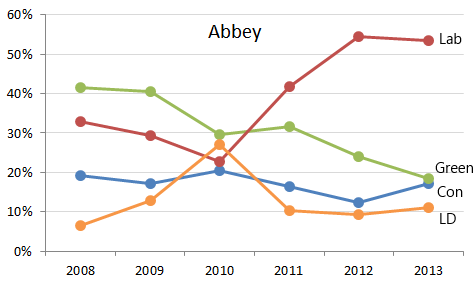
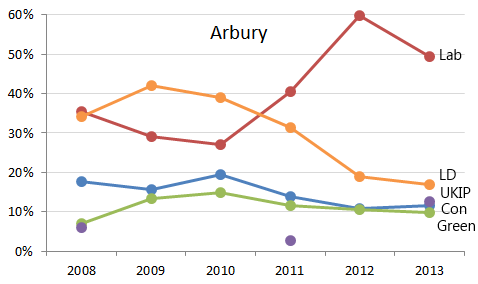
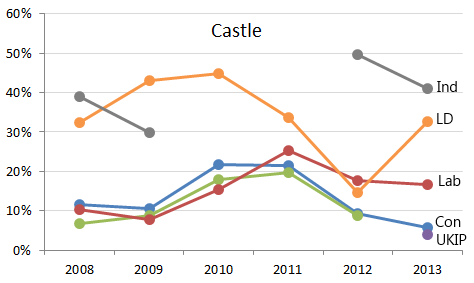

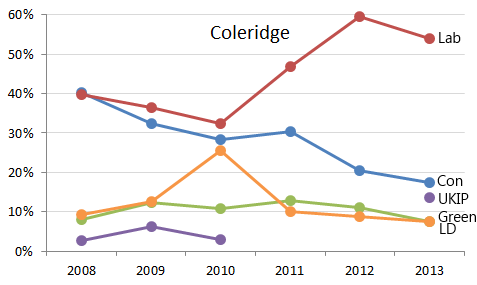
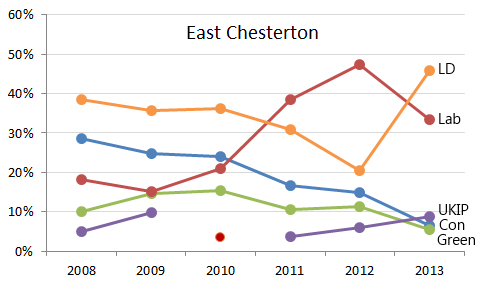

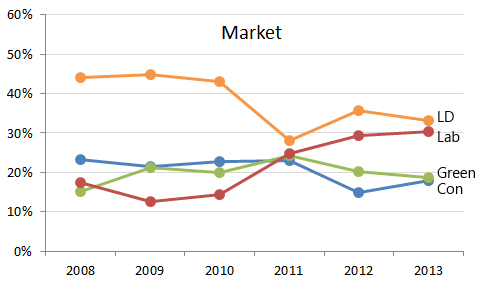
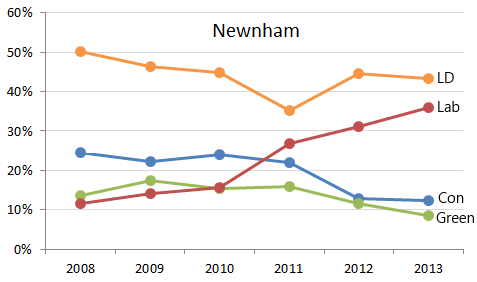
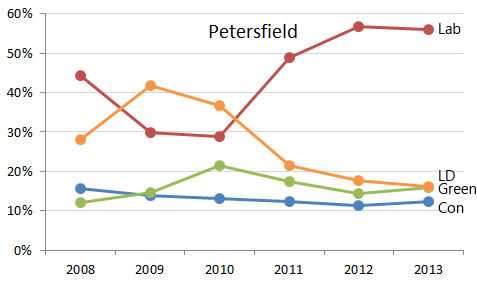
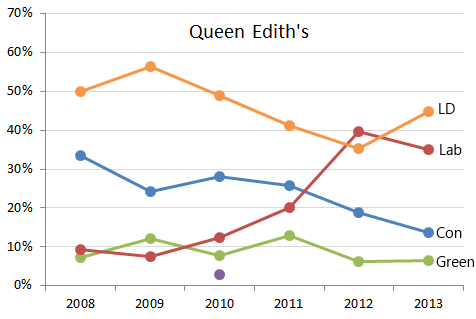
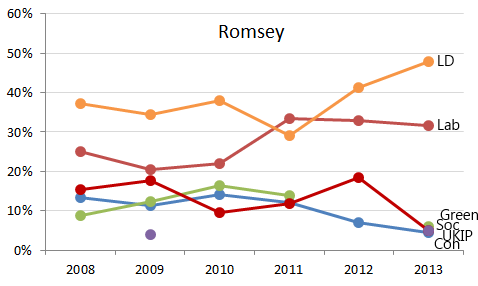


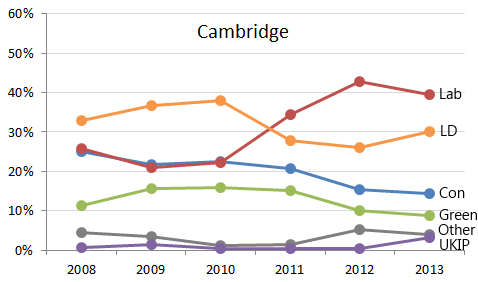
“Julian Huppert’s Cambridge seat covers the same area except for Trumpington ward.” Queen Edith’s you mean!
Aaargh! Thanks, fixed.
Out in the hinterland we’d love to see a similar analysis of South Cambs
Pingback: Cambridge City candidates for the county council elections on 04 May 2017 – A dragon's best friend
Pingback: Cambridge City candidates for the county council elections on 04 May 2017 – A dragon’s best friend | Public Sector Blogs